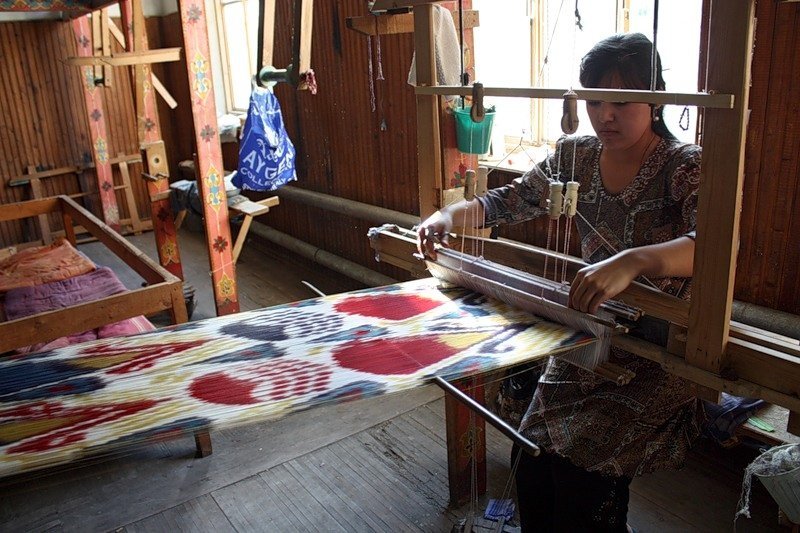Cotton weaving vs silk ikat weaves
The weaving of cotton cloth was the most common domestic handicraft of the oasis towns and villages until the nineteenth century. Almost every household possessed a loom for the manufacture of cotton cloth for the making of garments, turbans and girdles, as well as coarse calico for the family’s use and for sale in the bazaar. Woven cotton fabrics displayed regional variations in the designs and colours. Patterns were largely restricted to stripes and checks, but with a sophisticated application of stripe-width and colour-balance. The finish of the cloth was important. For some sloth used for dress material finish by glossing was part of the fabric production, and weaves from the surrounding area would bring woven length to the kudunggari or glossing workshop. The process of glossing involved the cloth being soaked in the foam of white of egg, beaten with wooden hammers, and pressed between flat stones. This gave a stiffly starched fabric with a distinctive moiré effect.
Many different types of woven cotton were developed. The most widely distributed coarse cotton cloth, karbos, was made of hand-spun yarn that had been boiled and starched before being threaded on the loom. The weft was thicker than the warp, and was continually moistened to facilitate the weaving process.
Gradually, as machine-spun yarn from the Russian spinning factories became widely available, it was combined with hand-spun yarn to produce some interesting cloths. One, salori bulur, was woven in the natural colour, white, and was given a texture by combining thick and thin threads in the warp. It became popular around Khodzhent for bride’s garments. A light muslin, patis, made from machine-spun yarn in the warp and weft, was produced in Samarkand. Much of this was sent on to another workshop to be bleached in a solution of potash and lime. Cloth of similar weight woven with a contrasting blue weft was also popular as a turban fabric. Alocha, a fine cotton cloth in a variety of coloured stripes and frequently worked with a coloured weft, was used for men’s coats and for linings. It is manufactured in factories and is popular over a wide area today.
Contrasting colours and yarns in warp and weft are used to give a fabric a ‘shot’ effect, a popular combination being that of extremely narrow stripes of white silk and dark-blue cotton, woven with a dark-blue weft, named paripasha, – ‘fly’s wing’.
Ikat silk-weaves
Although the introduction of Central Asian abr silk fabrics is relatively recent, and this unique cloth was made for Muslim patrons, nonetheless the nishonzan or ikat-designers chose their motifs from an artistic tradition several thousand years old. Pomegranates, tulips, rams’ horns, scorpions, and other motifs according to the region of production, are stylized but still recognizable. Frequently designs are of a single motif on different scales. Workshops developed individual styles, and cloth may be recognized as originating in a particular area. Lola gul (tulip), kutch karagul (ram’s horn), daira gul (tambourine), and shone gul (comb-flower), are typical designs from Bukhara, with reds and yellows predominating.

First the silk threads of the warp-length of 240 metres were wound with crosses in the usual way, and then divided into hanks or livit, which might be of no more than ten threads each. To keep the livit in order, the warp was carefully wound between two rods set the length of the design-repeat apart. The winding usually formed about eighty layers. The characteristic white mark which shows at intervals across abr fabric is caused by the fold where the rod presses against the warp, causing it to resist the dye. Some specialist workshops produced twill-weave abr fabrics, others a satin-weave known as atlas. One of the last of the Emirs of Margellan was particularly fond of a dense all-silk satin-weave abr fabric which thus became known as khan atlas. It was woven on a complex threading of eight heddles, so that the ikat-dyed warp gave a clear pattern in the smooth satin-weave surface.
Early in the nineteenth century, at the height of production of luxurious fabrics, there appeared silk-velvet ikat, baghmal, the most costly and exclusive weave of all. For the manufacture a complex threading of a double warp was necessary. A foundation-warp of plain orange or pink silk threads was threaded alternately with an ikat-dyed warp several times the length of the plain warp and set on a separate beam. As the weaving with a cotton weft progressed, the ikat-dyed warp was raised separately over grooved wires inserted on alternate picks. After a section was woven, a sharp blade was run down the grooves, leaving the velvet pile with its clear ikat pattern held by the alternate pick of cotton weft. Abr silk was used for clothing, for wallhangings, pardah, which were made of joined panels and often combined fabrics with different designs, for curtains, for doorways, and for tent-walls at festive outdoor gatherings. Bed-covers, adiol, made of padded quilted cotton, were often covered with abr fabric.

